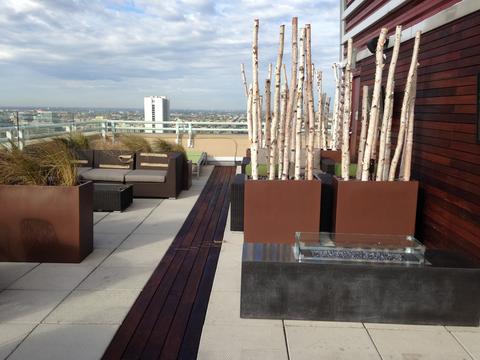Haute Hardscapes: Using This Essential Design Element In Any Outdoor Space
Posted by Jason Wyrwicz on Sep 14th 2016
By Jason Wyrwicz. President of Pots, Planters & More.

The creative use of hardscapes - juxtaposing lush plants and vibrant greens against solid permanent fixtures - creates an eye-pleasing design element of design while subtly laying a landscape's framework, transforming outdoor areas into something spectacular.
The term "hardscape" can be used to describe any material within a landscape setting that is not a living plant material, explains Clive Newey, owner of North Carolina-based Outdoor Artisan, Inc. "Within the industry, however, it more specifically refers to a hard planned or designed surface that accommodates outdoor living activities, features and furniture,” says Newey. Hardscapes not only enhance a garden’s design, but vastly improve the usability of outdoor spaces. It’s often the patio, stone path or fire pit that is the catalyst to draw guests into “outdoor rooms.”
"The best outdoor living space should feel natural and intuitive to you and your guests, and allow people to be drawn to the area without someone having to direct or explain what to do, where to go or where to sit.”

A Blend of Hard and Soft:
Adding plant life to hardscapes can soften outdoor areas and add much-needed color and texture. Let your hardscapes bloom by filling vertical spaces with tall planters that work as dividers, providing a beautiful border for a patio. Filled with sculptured shrubs, these box planters further a modern theme, and the greenery nicely edges grey spaces. Smaller pots perfectly dot a stairway when housing flora with colorful leaves, like the multi-hued heuchera plant. Flank a gate or add interest to a fence with alternating rows of planters in patterns of contrasting colors or shapes.
Building Blocks
When executed smartly, incorporating several types of hardscapes can make for a more interesting and dynamic outdoor blueprint. Flat spaces, such as a courtyard, can graciously host an al fresco dining table, while stone pathways lead to a quiet oasis and the ever-popular fireplace beckons on a cool autumn night. “Fire features of some description, whether it be a fireplace, fire pit, fire bowl or fire table, remain the top and most popular feature and they have been for some time now,” confirms Newey.

However, whether choosing just one focal element or blending several kinds of hardscapes, restraint is in order. "A general trend I see developing, and encourage, is the "less is more" approach. Size is not everything, and bigger is not always better. People are beginning to see and understand the benefits of quality over quantity in outdoor living. A smaller, well-designed and beautifully installed space will trump a large, mediocre area every time.”

Urban Appeal:
When hardscapes are city-bound, bringing in more natural life and earthy textures is a challenge. Plant life in containers does its best work on hard surfaces, offering nature’s bounty in a concrete jungle. Draw the eye and bring in a palette of colors with well appointed planters on and around an outdoor seating area. A rounded planter plays off nicely with a more architectural shaped leaf like the “golden sword” yucca and pairs well with most flowers for added color.

Balancing Act
Blending hardscapes and softscapes is an art form, with the end goal being a harmony of nature’s splendor and created elements.
To achieve this balance Newey suggests keeping these six points in mind:
- What are the surroundings and/or naturally occurring local materials?
- What architectural materials have been used in the buildings or home, and is it possible to incorporate even just a little of those into the design?
- Keep the material palette suitably narrow. A loose guide to this would be to use the same material or colors for horizontal surfaces and contrast the vertical surfaces with another color. One of those two surfaces could have a variety of color tones blended, while the other has a more monochromatic look to it.
- Accent the design with no more than two materials. This could be wood or a strikingly contrasting brick or stone from the home used more sparingly.
- Proportions, both within the overall space you have to work with, and between each feature within the space itself, must feel right.
- You can never go wrong with a few well-placed boulders.
Hardscapes are an essential ingredient in landscaping, enhancing outdoor design by adding structure, fire, water, and functional appeal.